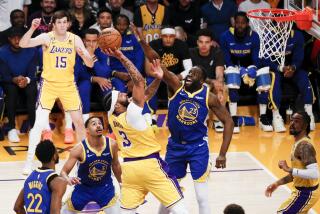Logo-rhythm
I saw Jerry West do something nobody has seen for 30 years.
West was perhaps the best shooter in the world in the 1960s and ‘70s. He blistered the nets, silencing talkative defenders at the game’s highest level. His Lakers were perennial finalists, and years of heartbreak at the hands of the Boston Celtics were finally assuaged when West’s Lakers won the NBA title in 1972, beating the New York Knicks in the Finals.
West has been affiliated with the NBA for more than 45 years. He averaged 27 points a game years before the three-point line and was named first-team All-NBA 10 times.
Later, he coached the Lakers for three successful seasons, then moved into the team’s front-office, where he assembled an empire on the shoulders of Shaquille O’Neal and Kobe Bryant. Burnout, or a mysterious falling-out, led to a retirement from the Lakers in 2000. It was a brief vacation: 20 months later the Grizzlies offered him enough money to fill a Memphis FedEx truck to head the team’s basketball operations. In July, after five years with the Grizzlies, West retired.
So this season will mark the end of an era in the NBA: no Jerry West, although his image is still the league’s logo. He’s on every uniform, sock, headband, poster and towel.
West is legendary not just for his classic jump shot, but also for his reclusive and private nature. If you spot him at a pre-draft camp or summer league game, he invariably has his back to the wall in the last row.
West likes his privacy.
Who can blame him? After several million autographs and pictures, the former small-town West Virginia kid has had enough. Still, West will sign autographs -- he has a smile for the kids, but is businesslike with the adults. He’s grown up, and he probably wishes the other grown-ups would grow up too.
In the spring 2004, I got a call from Dick Versace, then the Grizzlies’ general manager. Back when he was Coach Versace, and his Bradley Braves were terrorizing the Missouri Valley Conference, he had brought me to campus to work with his players on my ballhandling drills. I had been the worst player in North Park College history, and couldn’t make my high school team, but as a neurotically obsessed teenager I practiced my ballhandling drills whenever I could -- and especially at my summer job, guarding the college tennis courts that nobody used. The tennis courts became my private practice place for dribbling drills. I got quite good, although I found this out: Your jump shot won’t improve much at the tennis courts.
Because I practiced in private for years, Versace saw something that few others had. After Bradley, he connected me with guard Vern Fleming of the Indiana Pacers, then coached by Versace. Word of mouth led to lessons with Nancy Lieberman. I was an assistant at Texas El Paso by then, and when UTEP’s Tim Hardaway became an instant NBA sensation, my rep as a dribbling guru was intact -- although Hardaway was self-taught, somebody had to get credit for his killer crossover.
The Grizzlies, Versace said, wanted me to connect with forward Shane Battier in Memphis. If that went well, they’d want me to go to Los Angeles to work with former UCLA guard Earl Watson, who still summered there.
“There’s a high school kid who we’d like you to work with too,” Versace said. “His name is Jonnie West.”
“Sounds like a country and western singer,” I said.
Versace told me it was Jerry West’s youngest son. When I hung up, I noticed my palms were sweaty.
This was going to be pressure. The only thing that might be more pressure would be teaching Jerry West’s son to shoot. Or maybe being Jerry West’s son and trying to find your way as a player.
Battier is genuinely a nice guy, but he’s as stubborn as cement. He wouldn’t even attempt the next drill until he could come close on the previous one. But Battier did fine, and Jonnie West did nearly as well -- although he was just 15 at the time, you could see his loose-jointed athleticism, and his body learned fast. (Jonnie West is now a point guard for his dad’s alma mater, West Virginia.)
Battier or Jonnie West must have said something good to somebody. My e-ticket to Los Angeles came the next week, along with directions to Jerry West’s home.
You might think that after 40-some years in the NBA, Jerry West’s house would be like Trump Tower West. You’d be wrong. It’s unassuming, understated, tidy and tasteful. Also, Jerry West reads the paper. The headline in his L.A. Times that morning addressed the crumbling of the Lakers dynasty: Shaq was gone.
Once Earl Watson arrived, Jerry West told me where we’d be practicing: their neighbor had built a state-of-the-art gym behind his house. So Jonnie and I piled into Earl’s Mercedes, and we drove 200 yards up the street.
The floor was newly varnished and glistening like a new dime. The Lakers insignia at center court was identical to the one at Staples Center. Lakers championship banners hung on the wall, and I couldn’t find one that Jerry West didn’t help hang. Figuratively, I mean. There was a ball rack with a dozen regulation NBA balls and a small fridge stocked with filtered water.
We got started, and after a few minutes of simple warmup drills, the corner door swung open. With the morning sun behind him, I couldn’t make out any features, but there was no mistaking the silhouette: it was The Logo. It didn’t occur to me until that moment that the image of The Logo could be either coming at you, or dribbling away.
Jerry West popped open the fridge, grabbed a water and sat in one of the Lakers-insignia padded chairs.
I’d done dribbling demos in front of hundreds of coaches and campers for years. It’s one thing to perform for a bunch of sweaty kids taking a break from two hours of drop-step drills. But there’s a different pressure when Jerry West sits down to watch you work.
Earl and Jonnie continued with the slow-motion footwork-coordination drills I’d developed; nothing showy to the unlearned eye, but much more difficult than it looks.
When we began the more strenuous full-court stuff, Jerry West suddenly appeared behind me. Earl and Jonnie were doing what some coaches call an “inside-out” move, what I simply think of as a fake crossover. The ball never changes hands, but the dribbler threatens to cross up his defender.
“I’ve always thought this was the most important thing a guy could do,” Jerry West said.
That was a relief. What if he’d said my drills were a waste of time?
“Hell, this is all I could ever do with the ball,” he added.
I could have said, “Yes, and you could shoot a little bit.” But I didn’t. I figured Jerry West wasn’t the kind of guy who fished for compliments, especially on his shooting.
In fact, I didn’t think shooting would ever come up during my dribbling drills routine. But I always instruct the dribbler to stop and shoot at the end of any full-court stuff. Stopping under control is an overlooked part of ballhandling. So as the drills progressed, the guys would finish with midrange jumpers. Earl Watson’s shot bounced in and out several times, and Jerry West was at my shoulder again.
“Rus,” he said, “do you mind if I show Earl a few things about his shot?”
I’ve made a lot of bad career decisions and coaching mistakes. I walked away from a lucrative job as a New Mexico State assistant to be a writer; that was only the most recent of many. But I knew how to answer Jerry West’s question. I clasped my hands behind me, took a step backward.
Jerry West didn’t think Earl had the best rhythm on his off-the-dribble shot. “This is the first thing you should be able to do,” he said. And from the three-point line, he took two dribbles straight at the basket, stopped, and neatly banked it in. Then he went back and did it again a few times. There’s no mistaking (even if I had been too young to recall his game) that Jerry West is an athlete. He has long arms, big hands, square shoulders, and even at 69 he probably has a better vertical leap than I ever had.
Jonnie West whispered to me, “He just had a procedure done on his heart.”
I didn’t know if that meant the shooting display was even more amazing, or that it was an unnecessary risk to be popping jumpers in July.
Was I supposed to stop Jerry West? Instead, I began rebounding, which proved to be the most predictable job in basketball: just stand there under the net, son.
Jerry West moved to the other side and banked in a few more after dribbling with his other hand. But he must have felt that Earl’s rotation and release were an issue, because he went to the foul line and sank 10 in row, all the while stressing elbow positioning and hand placement.
“These ought to be automatic, Earl,” Jerry West said. And with that he closed his eyes and sank three more. One of them nicked the rim, but the rest were totally twine.
Then Jerry West said, “It’s important for a guard to be able to shoot with different arch on the ball.” I knew I’d better listen up. And Jerry West shot in midrange jumpers from different spots, with three different arches -- flat, regular and high-arching.
“You’ve got to practice enough so you know every spot on the floor,” Jerry West said. And with that he walked off the court, toward the corner. I thought he was finished, and quickly flipped through my mental index cards: What was the next dribbling drill?
But before I could say, “OK, between the legs now after a jump-stop,” Jerry West paused on the baseline, where the NBA three-point line connects. Then he stepped off the court, meaning out of bounds, but still behind where the three-point arc would be, if it continued. Without bouncing the ball, he squared himself.
From that angle, a shooter can barely see the rim. You’re actually behind the backboard, and need to get just the right arc and release -- there’s zero margin of error. Watson looked at me, and raised his eyebrows. I moved from under the net, out toward the wing where the ball would likely carom after nicking the backboard. A basketball rim is wide enough to fit two balls through at the same time, but from that angle, off the court near the corner, you have to be perfect.
Jerry West was perfect.
Jonnie knew to stand under the net, as I had earlier. He snapped a chest-pass back to his pop, who dropped two more in before he glanced the backboard, and the ball bounced to me.
Nobody spoke, they just looked at me, and I knew it was time to get back to ballhandling. So I got them started on a full-court change-of-pace exercise. As Earl and Jonnie took off, I yelled at them to keep their eyes up. I backed up to the baseline, and nearly bumped into Jerry West, who hadn’t gone back to the bench just yet.
“I sure hope Jonnie will work hard all summer on this,” he said.
I’d been with Jonnie nearly two weeks, and I said he’d made remarkable improvement already. I was more comfortable discussing dribbling than shooting. But shooting must have still been on his mind.
“I don’t like to brag,” Jerry West said. And that was surely true. “But I used to be a hell of a shooter. I mean, I could really shoot the ball.”
And it didn’t sound like boasting at all -- there was a real sadness in his voice -- as if he truly missed lighting up the league with jump shots and understood that those days were long gone.
And then Jerry West walked away, back to the bench. He had to pass in front of the open door and the morning sunshine first, and once more his outline was framed by the doorway. I flashed on that image again: The Logo.
--
Rus Bradburd is the author of “Paddy on the Hardwood: a Journey in Irish Hoops.” He teaches writing classes at New Mexico State University.
--
Begin text of infobox
The timeline
May 28, 1938: Born in Chelyan, W.Va.
1953-56: Played basketball for East Bank (W.Va.) High. Was named All-State from 1953-56 and was West Virginia player of the year in 1956.
1956-60: Played for West Virginia University
1959: West averages 26.6 points a game and is named an All-American.
1960: Scores 29.3 points per game and is again an All-American. In his career, West averages 24.8 points and 13.3 rebounds. He still holds school records for points scored, points per game, field goals made, free throws made, free throws attempted, rebounds, double-doubles, 20-point games and 30-point games.
1960: Member of U.S. gold medal-winning Olympic basketball team.
1961-62: West establishes himself as a scoring threat in his second season in the NBA, averaging 30.8 points, the first of four seasons in which he averaged better than 30 points.
1965: West averages 40.6 points in 11 NBA playoff games. His 46.3-points-per-game average against Baltimore in the division finals is a record for a six-game series.
1969: West becomes the only member of a losing team ever to win the Finals MVP award.
April 29, 1970: West makes a 63-foot desperation shot at the buzzer to tie Game 3 of the NBA Finals against the New York Knicks. The Lakers lose in overtime.
1971-72: West averages 25.8 points for the 69-13 Lakers and leads the NBA with 9.7 assists per game. West also wins his first and only NBA title as a player.
1973-74: A pulled groin limits West to 31 games.
1974: West, 36, retires as the NBA’s third-leading career scorer, behind Wilt Chamberlain and Oscar Robertson, with 25,192 points in 932 games.
1976-77: West becomes the Lakers’ head coach. In three seasons with West at the helm, the Lakers go 145-101 and return to the playoffs after missing the postseason during West’s absence from the team.
1982: West is named general manager of the Lakers; they win five titles on his watch, two more with roster he primarily built.
2002: Named president of basketball operations by the Memphis Grizzlies.
2004: Grizzlies win 50 games for the first time, and West is named NBA executive of the year for the second time.
2007: West retires after the Grizzlies post the NBA’s worst record, 22-60, and an era ends. West, part of the NBA for more than 45 years as player, coach and executive, had a hand in nine Lakers titles.
--
Sources: NBA.com, hoophall.com, Los Angeles Times
More to Read
All things Lakers, all the time.
Get all the Lakers news you need in Dan Woike's weekly newsletter.
You may occasionally receive promotional content from the Los Angeles Times.





